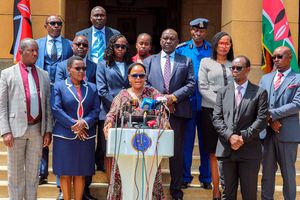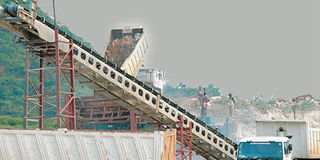
limestone mining site in Pokot District. Photo/FILE
Mining licences for limestone, titanium and gemstones are now the most sought after by investors in Kenya, a top official said, marking a shift from traditional crowd-pullers such as gold.
Mining Principal Secretary Elijah Mwangi said the increased demand for these ores is driven by booming infrastructure projects, technological advancements, and the growing need for the globe to go green.
“We have seen a significant increase in interest over the years, with investors focusing on these minerals.
"Limestone is essential for cement production, titanium plays a crucial role in construction and aerospace, and gemstones, prized for their beauty and rarity, are primarily used in jewelry and decorative applications,” he said in an interview.
“We have given four companies to establish clean carbon and for the titanium for example we want to hear the success stories to understand much about the interest in this and the third one that we have taken note of is the gemstone,” he said.
Limestone is a key ingredient in the production of cement, which involves mixing of clinker and limestone or coral rock mainly from coastal Kenya with pozzolana, an ash-based product mainly found in the Rift Valley.
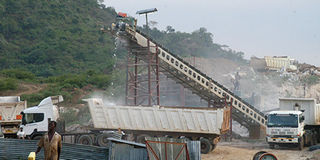
Lorries drive into the limestone quarry at Ortum in West Pokot. The limestone deposits have attracted a cement factory to West Pokot. Photos/JARED NYATAYA Photo/JARED NYATAYA.
Titanium is an important pigment for industrial, domestic, and artistic applications. It is also a choice material for joint replacement, tooth implants, and body piercing.
Australia miner Base Titanium, which formally shut its operations on December 31, 2024, had the most successful venture in Kenya generating more than Sh36 billion for the government in taxes and royalties from a decade-long stint.
Over the 10 years to June 2024, Base Titanium paid the government a cumulative Sh17.4 billion in royalties, and Sh12.3 billion in income taxes to the exchequer.
Mr Mwangi said the ministry has cleared a backlog of over 3,000 licensing applications since the lifting of a moratorium, leaving just 35 pending by December 2024.
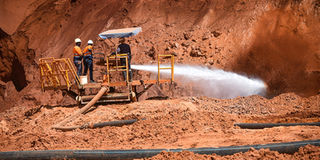
A mining site at Kenya's coast.
This streamlined process, he added, has unlocked approximately Sh244 billion, boosting mining’s contribution to the GDP to five per cent.
The phased lifting of the moratorium applies to minerals such as gold, manganese, titanium, gemstones, diorite, dolerite, granite, gravel, greywacke, gneisses, laterite, phyllite, quartzite, and others.
“The majority of the minerals being extracted in this country go unreported and untaxed.
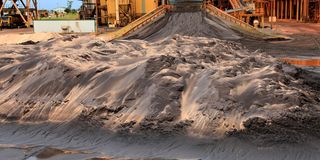
Operations at the Base Titanium Mining Plant in Kwale County in this photo taken on 29th June 2022.
"Just yesterday, (Tuesday) we arrested individuals involved in illegal mining and identified a consignment worth Sh200 million, which represents government revenue. If we had not intervened, these activities would have gone unnoticed. I can confidently tell you that the amount we collected by December was 50 per cent higher than expected,” the PS said.
Mr Mwangi said Kenya targets to grow value addition to maximise its mining potential.
“Our goal is to attract investors and ensure sustainable mining practices that benefit local communities and the national economy,” he said.











